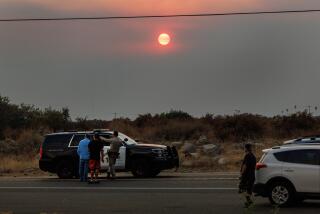Land-Use Controls Called Vital to Clean Air
ONTARIO â Land-use controls and careful management of traffic are essential if the Los Angeles area is to make headway in obtaining healthier air, officials with the South Coast Air Quality Management District and Los Angeles County district attorneyâs office told a state Senate review panel Thursday.
In testimony before the oversight panel, which is reviewing the performance of the air district, Jan E. Chatten-Brown, a special assistant to Dist. Atty. Ira Reiner, said population âgrowth anywhere nearâ projected levels will result in worsening air quality âunless we drastically change our transportation and land-use plans.â
And Thomas Heinsheimer, vice chairman of the AQMD board, told the panel that big housing developments or shopping malls that cause pollution by fueling growth should have to control or offset that pollution as major industries do.
Currently, however, âthere is no way of causing the construction . . . that leads to growth to pay its fair share of the increased air quality burden,â he said.
He said any legislative changes in the districtâs charter should authorize it or some other regional agency to make big developments include pollution controls or pay for air cleanup elsewhere--such as through purchase of methanol-powered buses.
Heinsheimerâs remarks came at a Senate Budget and Fiscal Review subcommittee chaired by state Sen. Robert B. Presley (D-Riverside). The subcommittee is one of two legislative panels studying the air district, whose rules and procedures are also being reviewed by the U.S. Environmental Protection Agency.
The scrutiny is prompted by certainty that the South Coast basin will fall far short of meeting a Dec. 31, 1987, deadline for attaining federal health standards for ozone, a major ingredient of smog, and carbon monoxide.
The district, which operates in Los Angeles, Orange, San Bernardino and Riverside counties, regulates stationary emission sources, such as factories and power plants, that together account for 45% of area emissions.
Critics of the district have accused it of weakening some rules and failing to follow through on plans to enact dozens of additional pollution control regulations.
But because the district regulates only stationary sources, even its sharpest critics have acknowledged that traffic controls and some other initiatives are beyond its authority.
Citing a study showing that the average late-model car spews twice as much pollution as it was designed to, district Executive Officer James Lents said the state Air Resources Board and Bureau of Automotive Repair should improve the stateâs smog-check program and require auto makers to install more durable emission control equipment.
Lents also said authority to manage traffic will also be critical to cleaning the air, since the number of cars in the basin is expected to increase 40% by the year 2000.
While agreeing that there are limits on the districtâs authority, some witnesses said the district hasnât effectively used the authority it has.
Chatten-Brown complained that too few cases are referred to the district attorney for criminal prosecution. âOf those which are referred by the district, none have been major, â she said.
AQMD officials say they collected $1.5 million in penalties last year, mostly through settlement of about 4,800 violation notices.
According to district counsel Curtis Coleman, the cases that county prosecutors âare interested in filing are willful air pollution violations that result in significant amount of excess emissions.â But he said âthe vast majority of our notices donât fit those guidelines.â
More to Read
Sign up for Essential California
The most important California stories and recommendations in your inbox every morning.
You may occasionally receive promotional content from the Los Angeles Times.










